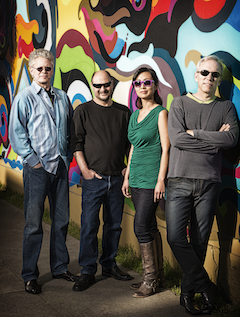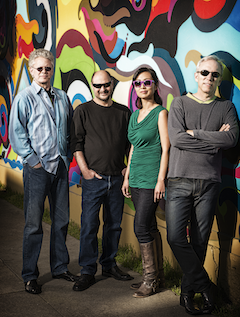
Concerts by the Kronos Quartet are known for featuring the new, the ambitious, and the amplified. Even so, the group’s program on Sunday night at Stanford University’s Bing Concert Hall felt significant even before they played a single note. Featuring seven works, all but one written within the last century, all written by or made popular by women, including four composers born after 1970, the concert served as a showcase for young talent and a challenge to the stubborn persistence of the dearth of women composers on chamber music programs. The results proved to be a mixed bag, albeit an unforgettable one.
Missy Mazzoli describes Harp and Altar (2009) as a “love song” to the Brooklyn Bridge, borrowing the title from Hart Crane’s poem about the same span. In the first of the concert’s many electronic additions to the musicians, Mazzoli’s work included a prominent sampled vocal appearance by Gabriel Kahane. Interrupting what had been, up to that point, a vivid and bright musical portrait of the bridge’s grandeur and location, the sudden appearance of Kahane’s sampled voice made it seem as if Moby had suddenly crashed a party now that dawn had arrived. Still, the work’s conclusion left an impression befitting the structure, with violinist David Harrington’s repeated ostinatos accompanying Kahane’s multi-tracked voice ascending skyward.
The premiere of Santa Ratniece’s silsila (2013) followed, moving thematically from bridges to the water they span, in this case the Brahmaputra River as it winds its way from Tibet to the Bay of Bengal. With small, scraping notes recreating the water’s ebb and flow, Ratniece does an impressive job of rendering a small river descending from the highlands, but over the course of the work’s seven continuous parts the music became trapped in a circular eddy and in the end it felt like the piece hadn’t gone far enough downstream to make it worth the entire trip.
Wild Rumpus in the Balkans
On the other hand, Aleksandra Vrebalov’s …Hold Me Neighbor, In This Storm… (2007) felt like an extended and exciting journey through uneasy Balkan terrain, complete with folk music, church bells, and sampled calls to prayer. Harrington did some damage with his bow to a gusle (one person accurately described it later as “a shrieking goose”), John Sherba pounded out alarms on a drum, and all four members of the quartet stomped their feet in unison as they sawed away over spinning melodies, which veered giddily off course like the musicians had suddenly entered the Roma camps in the film Gadjo Dilo. Mirroring the restlessness of the region, Vrebalov’s piece never stayed in one place too long, with detours into Rembetika and the hyperkinetic frenzy of Serbian wedding music, ending in a flurry of angry, slashing notes and three final, ominous booms.
Geeshie Wiley’s “Last Kind Words” (c.1930), arranged here by Jacob Garchik, is a catchy blues tune, plucked for the duration by second violinist Sherba, violist Hank Dutt, and cellist Sunny Yang, with only Harrington bowing to recreate the vocal line. As a jaunty entertainment it worked, but it was lightweight, as if it were created to be played on dozens of different Pandora stations.
The most straightforward piece on the program was “Ov Horachamim,” (Father of compassion) a traditional Hebrew song popularized by Yiddish theater star Fraydele Oysher, whose version served as the basis for the arrangement by Garchik and Judith Berkson. Its placement at this point in the program didn’t register for me, though it provided a spotlight turn for Dutt’s viola.
In retrospect it should have followed Margarita Lecuona’s Tabú (Taboo, 1941), a dance number arranged by Osvaldo Golijov featuring a canned percussion performance by Luis Conte. The presence of the pre-recorded drums took me out of the piece completely. I’m not averse to the use of sampling or the presence of electronica in live performances to create a sound or produce an effect which instruments cannot, but a canned rhythm section is no different in my mind than using a drum machine or a click track, with the added result here of reducing Yang’s cello to the role of little more than an accompanying rhythm bass. Hire musicians to play the piece live or play something else.
A Recreation of War
The centerpiece of the concert was Mary Kouyoumdjian’s Bombs of Beirut (2013), an ambitious three-part work with sections titled “Before the War,” “The War,” and “After the War.” Kronos chose it as the winner in their fifth Under 30 Project. It is based on first-hand accounts of the Lebanese Civil War, in a manner reminiscent of Steve Reich’s Different Trains &151; but with significant differences.
The first section featured music accompanied by spoken words. Equally matched in their amplification, you could follow the music or the words, but it was impossible for me to follow both at once. Switching back and forth between the two, I failed to connect with either, due to the lack of cohesion in the structure or the presence of a musical, narrative, or sonic relationship between the voices and instruments.
But “The War” section was devastating in more ways than one. Steadily but noticeably, the volume increased until suddenly the voices and the music stopped altogether. Then the sound of a bomb detonating filled the hall, followed by another, and another, and quite unexpectedly (and horrifically), the next few minutes became an auditory assault. The Bing’s marvelous speaker system recreated the sound of a full-on bombing attack in the darkened hall. Neither I nor anyone I spoke with afterward noticed any warnings in the lobby or the program about this portion of the concert, which was grossly irresponsible. I can’t begin to imagine how this segment might have affected someone with Post Traumatic Stress Disorder. As the barrage progressed, it grew increasingly oppressive, and then crossed the line into numbing terror. A few people left their seats, and a woman in tears was later spotted leaving the hall.
I can’t really tell you what the third part of Kouyoumdjian’s piece sounded like because the effect of the second had a lasting impact.
As an encore the quartet performed Laurie Anderson’s quiet, reflective Flow.

